Russian invasion of China began as early as late Ch’ing. During the Second Opium War, in the reign of Hsien-feng, the accumulative weakness of China was exposed to the world and Russia wantonly annexed Chinese territory. In the 26th year of the Kuang-hsü reign (1900), when China was attacked by the Eight-Nation Alliance, Russia seized the opportunity to expand her territory, and massacred those Chinese living in Hai-lan-p’ao (海蘭泡), the Sixty-Four Villages East of Hei-lung-chiang River (江東六十四屯), and Ai-hui City (璦琿城). It was similar to the massacre of Jews by the Germans in the last century. This happened in the borderland of China and most Chinese are no longer familiar with the details. The historian Mr. Shang Ssu-t’u wrote this article to chronicle the Russian Massacre. Russia has annexed one million two hundred and fifty square kilometers of Chinese territory, the equivalent of 34.5 multiplications of the area of Taiwan! It has been over one hundred and sixty years, and the lost territory has still not been recovered. In the past, during the May Fourth Movement (1919), Chinese students were willing to fight for the territory of Ch’ing-tao (青島). Today can we even gather one student or one soldier to demand our land back?
Curatorial and Editorial Department
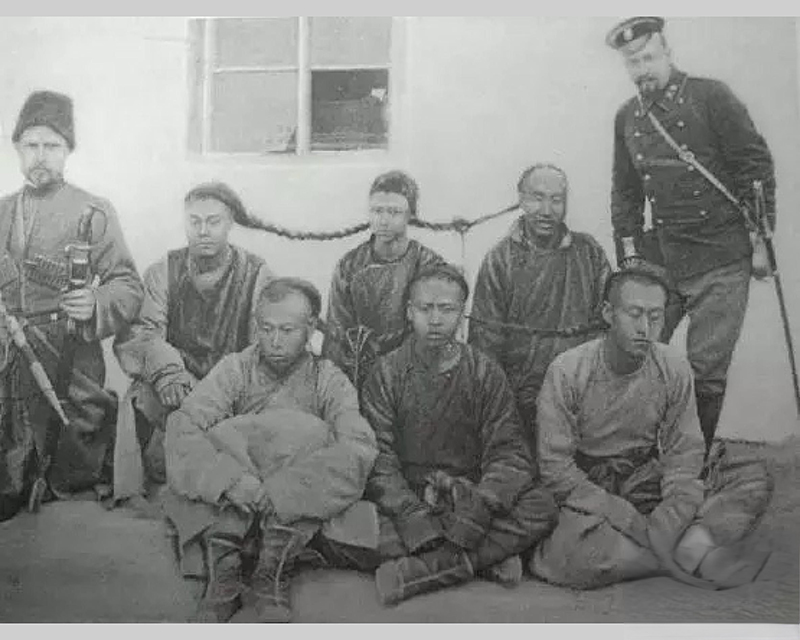
Chinese with queues tied by Russian soldiers ready for slaughter
In early spring the 26th year of the Kuang-hsü reign, keng-tzu year (庚子1900), the Boxer Rebellion broke out. Shortly afterwards, Empress Dowager Tz’u-hsi (慈禧) extended her full support, war was provoked, leading to the Eight-Nation Alliance of military intervention. Very soon the Alliance sacked the Forbidden City, Empress Dowager Tz’u-hsi fled the capital, and employed a whitewash term “Hunting in the West” (西狩) to camouflage the escape.
Russia was one of the main participants of the Eight-Nation Alliance. Not only did she invade Tientsin and Peking, she also invaded north-east China.

Portrait of General Shou Shan
The military general stationed in Hei-lung-chiang was Shou Shan (壽山 1860-1900), tzu Mei-feng (眉峰). He had been described in this manner:
“His nature was unyielding and brave, he had no intention to bend to anyone. He swore to die when the Emperor was humiliated, success or failure was disregarded.”
After the outbreak of the Boxer Movement, he ordered his men to set up stations section by section along Hei-lung-chiang (黑龍江 Amur River), reaching Hei-ho (黑河) to the north and Fularji (富拉爾基) to the south. They dug trenches and built ramparts, the total length of the defense stretched over one hundred and fifty miles. They were equipped with four heavy Wu-ti chiang-chün cannons from the Han Banner army and twelve Shen-wei cannons. These were assigned to defend different strategic passes. After completing these preparations, Shou Shan ordered his officers to blockade Hei-lung-chiang, saying:
“Any Russian ship navigating along the river, whether naval or merchant, must be met by artillery shelling, to thwart all Russian dealings and reinforcements.”
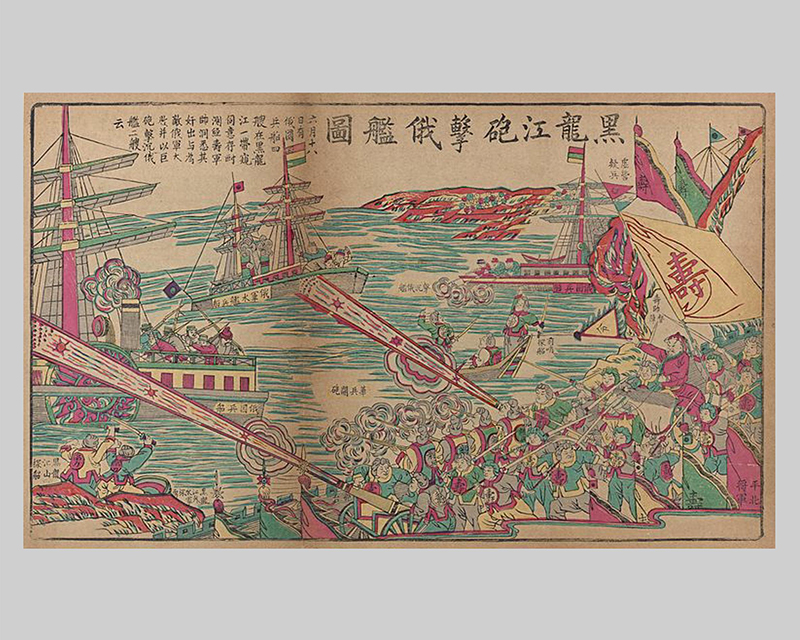
Artillery under Shou Shan firing at Russian ships
On 14th July (18th June for Chinese Agricultural Calendar) 1900, at one o’clock in the afternoon, a Russian ship Mikhail, towing five barges and fully loaded with ammunitions, passed by Ssu-tao-kou t’un village (四道溝屯), twenty five miles to the north of Ai-hui (璦琿) city. It left Po-li (伯力) and was on the way to Hai-lan-p’ao (海蘭泡). The Ch’ing garrison opened fire, and the vessel was forced to dock. The Chinese officers boarded the ship to inspect, but in no time, a Russian ironclad warship Selenge, used to transport soldiers, appeared and moved close to the Mikhail. The colonel on the Russian warship disembarked with a group of five soldiers, an eyewitness recounted:
“They rushed straight away to our flood control post to scrutinize…… the colonel’s manner was haughty and imperious,……..his countenance was fierce and pompous. He cursed and said: You bunch of swines, do you dare to challenge me?”
He ordered the Russian ship to ignore the Chinese, pull up the anchor to leave as soon as possible. When the ship was about to leave the shore, Russian troops started shooting at the Chinese soldiers, and the Chinese soldiers on the shore retaliated. The battle lasted half an hour, the Russian colonel was wounded, over twenty Russian soldiers were killed, a dozen wounded. After this, Russia premeditated the Sixty-Four Villages East of the River Massacre.
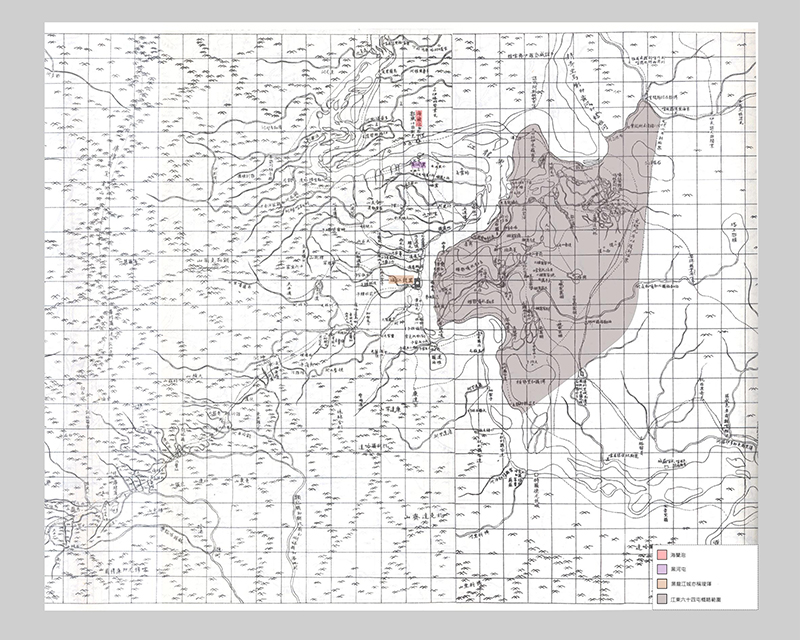
Map showing the locations of Hai-lan-p’ao and the Sixty-Four Villages East of the River. From Liao-hai ts’ung-shu (遼海叢書) : Map of Hei-lung-chiang
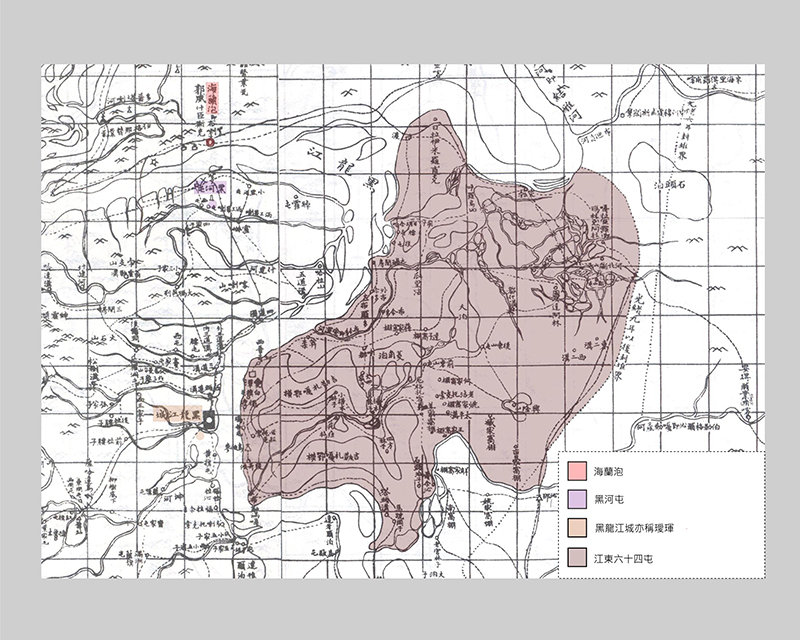
Detail map showing the locations of Hai-lan-p’ao and the Sixty-Four Villages East of the River. From Liao-hai ts’ung-shu (遼海叢書) : Map of Hei-lung-chiang
Hai-lan-p’ao was a city on the left bank of Hei-lung-chiang. Across the river overlooking Hai-Lan-p’ao is the city of Ai-hui (璦琿), now part of Hei-ho (黑河) city. In 1858, Russia partitioned the place through the unequal Treaty of Aigun. Six days after the signing, the name was changed to Blagoveshchensk. By 1900, the population was over thirty thousand, the majority was Chinese.
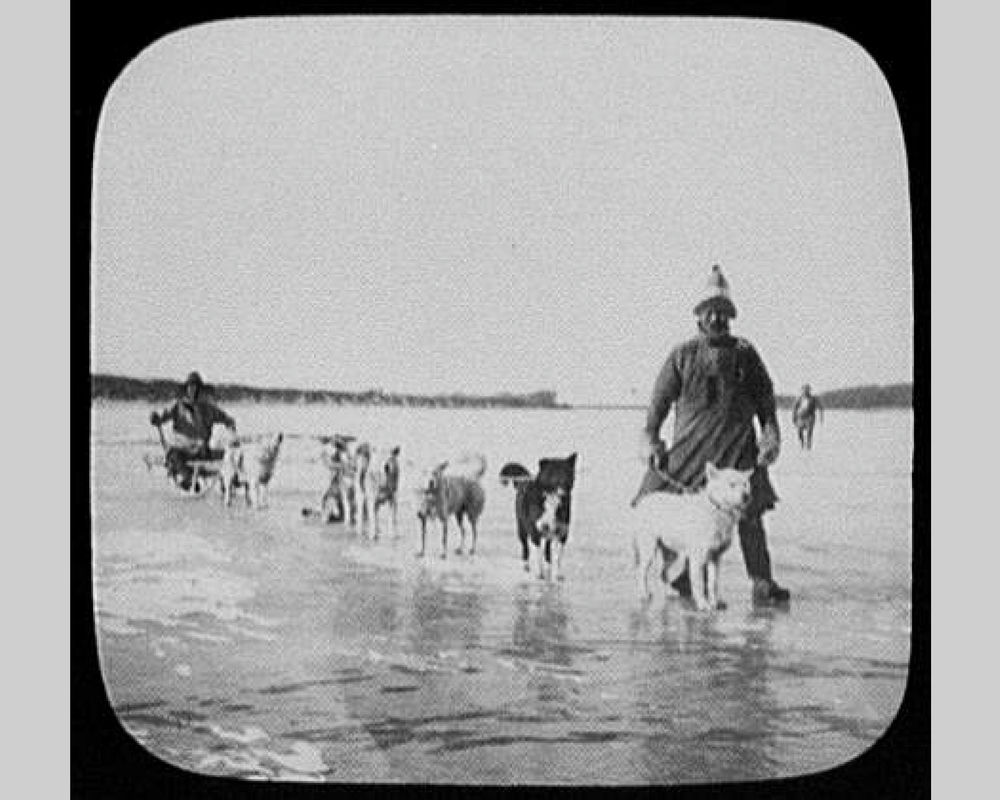
Manchurians in Hei-lung-chiang. Photograph taken in 1895. Courtesy Wikipedia

Manchurian houses in Po-li (伯力) City. Photograph taken in 1895. Courtesy Wikipedia
On 24th June 1900, the commander of the Russian army in Hei-lung-chiang (Amur) received news of the successful capture of the Taku Forts in Tientsin by the Eight-Nation Alliance. By dusk that day he issued a mobilization order: the Russian army in the military district of Hei-lung-chiang along the shore was to enter a state of war. After the failed provocation of the Russian ironclad warship on 14th July, on 15th July, Russian army stationed in Hai-lan-p’ao attempted to invade Ai-hui, and was repelled by the Chinese soldiers and residents there. Meanwhile, the Russian military in Hai-lan-p’ao started to expel and persecute the Chinese residents in the city, plundering their properties and ransacking their shops. On 16th July, Russian soldiers carrying long axes hunted and captured a few thousand Chinese, some were detained in the police building, those that could not be accommodated, were detained in a carpentry factory in Mo-erh-chin (莫爾金) next to the Ching-ch’i-li River (精奇裡江 Zeya River). The next day, on 17th July, scores of Cossacks and police deported these Chinese captives to the river shore. Those who trailed behind were hacked to death. At the shore, with knives, axes and guns, the Chinese were pushed into the river. Those who could not swim were drowned, those who did not dare to enter the water or resisted were instantly hacked to death.

Bound volume of Russian newspaper covering military affairs between July and August 1900. Photograph courtesy Boris Yeltsin Presidential Library
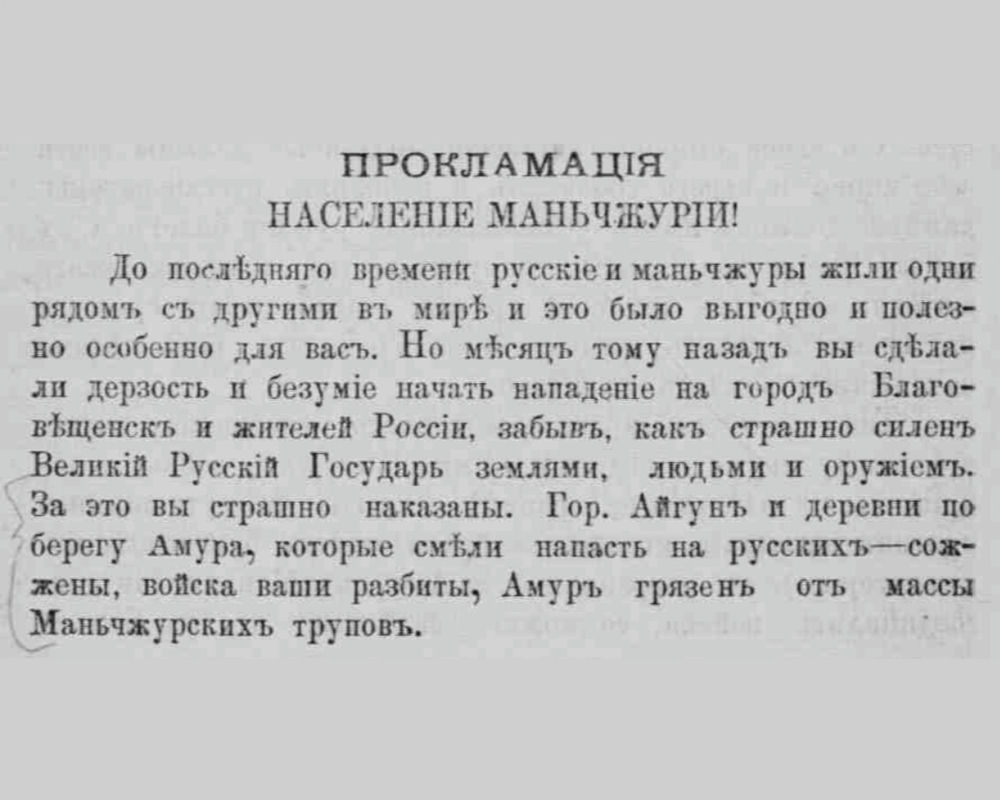
Page 14 of bound volume dated 1st July 1900, published the preface of the declaration by Russian General K. N. Gribskiy, asserting punishment of the Chinese in Hai-lan-p’ao and the Sixty-Four Villages East of the River. Photograph courtesy Boris Yeltsin Presidential Library
According to the County Annals of Ai-hui, it is so recorded:
“At eleven o’clock before noon, looking at the opposite shore from a distance, the Russians expelled countless resident Chinese, they formed rows and rows along the bank, the noises thundered far and wide. Gazing carefully at the Russian soldiers, they were holding knives and axes, hacking away to their right and left. Body parts and bone pieces, screams brought tears to the listeners. The seriously wounded died on the shore, the less injured died in the river, those not injured were drowned, corpses and body parts floated everywhere, covering the river. Some eighty survivors were found, saved by the waves, they were without clothes, in coma, and lost their speech. After they were nursed by the Chinese military doctors, they came round to tell that over five thousand resident Chinese were slaughtered and drowned. They were given sets of clothing and left.”
The Russians repeated this massacre three times, over ten thousand resident Chinese were slaughtered in Hai-lan-p’ao.
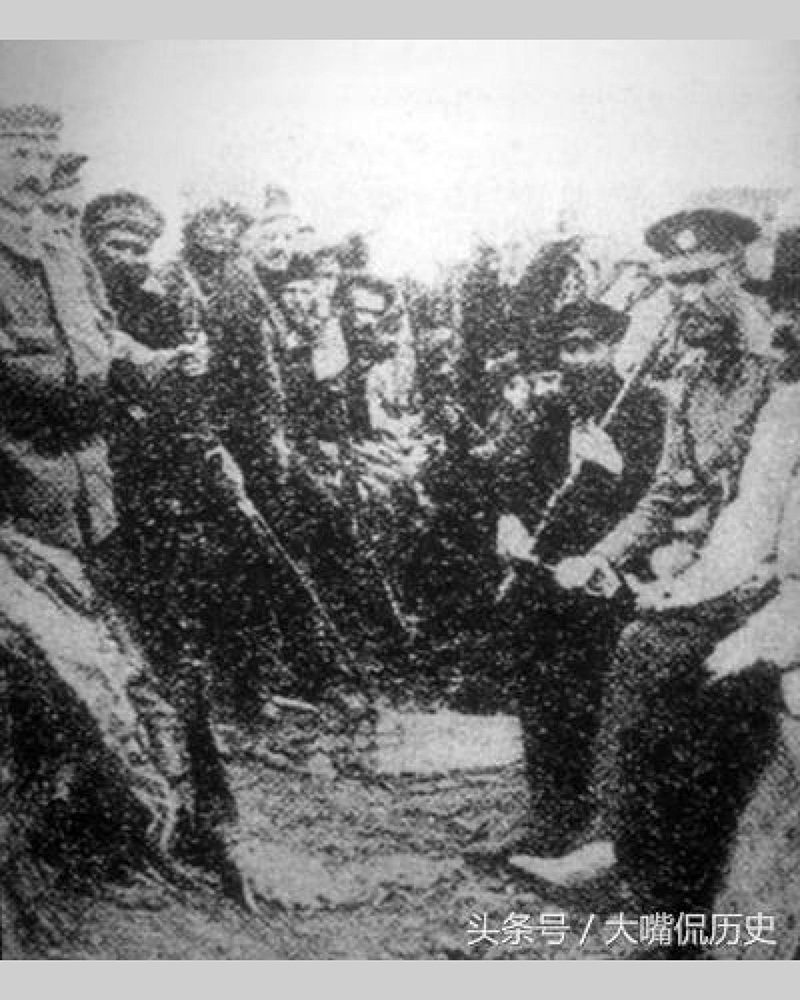
Russian soldiers carrying out massacre in the Sixty-Four Villages East of the River
At the same time, Russia used this opportunity to occupy the Sixty-Four Villages East of the River, evicting and slaughtering the Chinese who had lived there for generations. The Sixty-Four Villages East of the River were located at the left bank of Hei-lung-chiang, beginning from the east of the Ching-ch’i-li River junction, to Huo-erh-mo-le-chin t’un village (霍爾莫勒津屯) of Sun-wu county (孫吳縣) across the river, in Hei-lung-chiang province. From south to north the distance was approximately 150 miles, from east to west the distance was approximately 80 miles. The residents were Manchurians, Han Chinese and Daur people, they numbered over 30,000. This land originally belonged to China. In 1858, Russia coerced China into signing the unequal Treaty of Aigun, partitioning 600,000 square miles of land over the left bank of Hei-lung-chiang. For the Sixty-Four Villages East of the River, there was an agreement:
“Those Manchurians and others who originally live in this area, are allowed to continue to live in the different villages permanently. They will still be governed by the Ch’ing officials. They will live in peace with the Russians, and will not be violated.”
However, Russia long coveted this area, before this, immigration was used tactically to occupy the land piecemeal. The day after the 17th July massacre of resident Chinese in Hai-lan-p’ao, the Russians detained the resident Chinese in the Sixty-Four Villages East of the River. According to contemporary chronicle:
“Confined them to one large building, and set fire to kill countless of them. Less than half survived.”
Those who escaped fled across the river, many were killed before they could reach the river bank, many more drowned. The Russians set fire to the Sixty-Four Villages, and they were razed to the ground.

Chinese tied up by Russian soldiers for execution
In the evening of 1st August, Russian troops under cover landed at Wu-tao-huo-lo (五道霍洛). In the morning of 2nd August, Russian troops that combined artillery, the few thousand cavalry and infantry who crossed the river, and those originally stationed in Hai-Lan-p’ao, together attacked Hei-ho village from land and river. After four hours, Hei-ho village was occupied. They continued onward to Ai-hui, and encountered heavy resistance by the Chinese soldiers and residents. On 4th August, commander of the Russian army in Hei-lung-chiang (Amur) ordered an additional 10,000 troops to attack Ai-hui from the east, south and north. The Ch’ing soldiers and the Boxers continued fighting until they were overwhelmed. After the Russians captured Ai-hui, they set this ancient city on fire, a few thousand houses were turned to ashes. All that is left of the former city is the K’uei-hsing Tower (魁星樓).
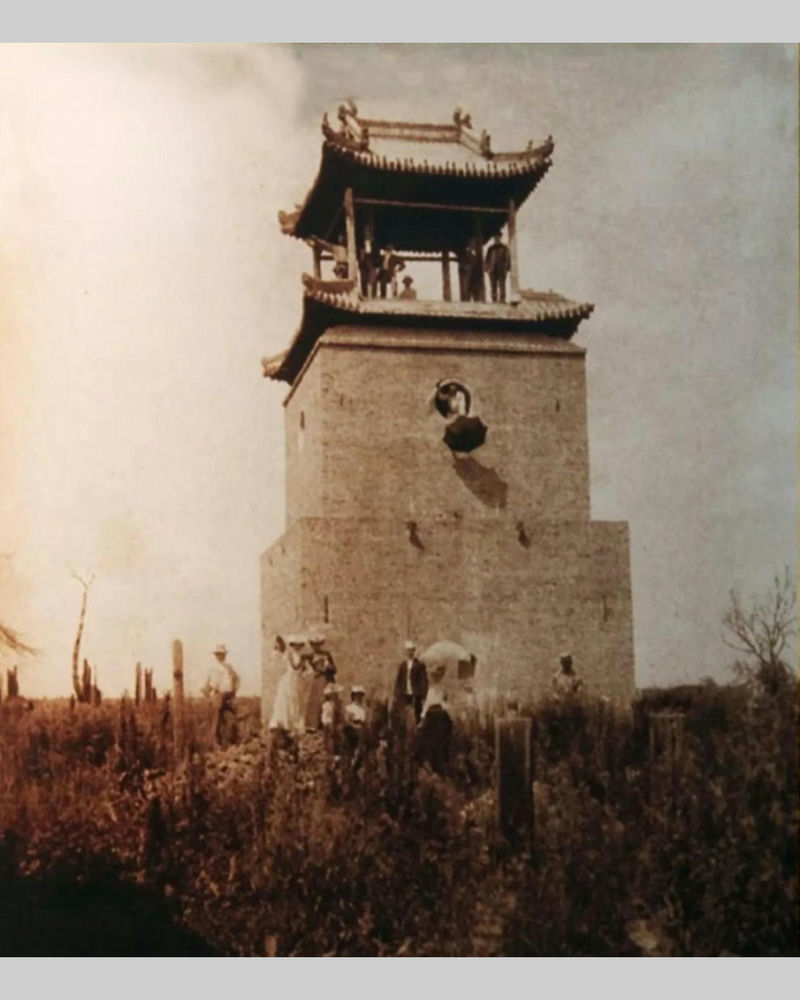
K’uei-hsing Tower, sole surviving building after the destruction of Ai-hui. Photograph taken in 1904
On 28th November 1900, there was an article in Shen-pao Newspaper (申報) titled: A Catastrophic Encounter in Hei-lung-chiang. The author blamed the catastrophe on Shou Shan for his recklessness. According to this author, not only was the action by Shou Shan not patriotic, by acting so rashly he endangered the lives of countless Chinese. Once the battle began, within the span of a month, the whole province fell to the Russians. Although Shou Shan sacrificed his life for the country, his role in the development of these historic events was called into question.
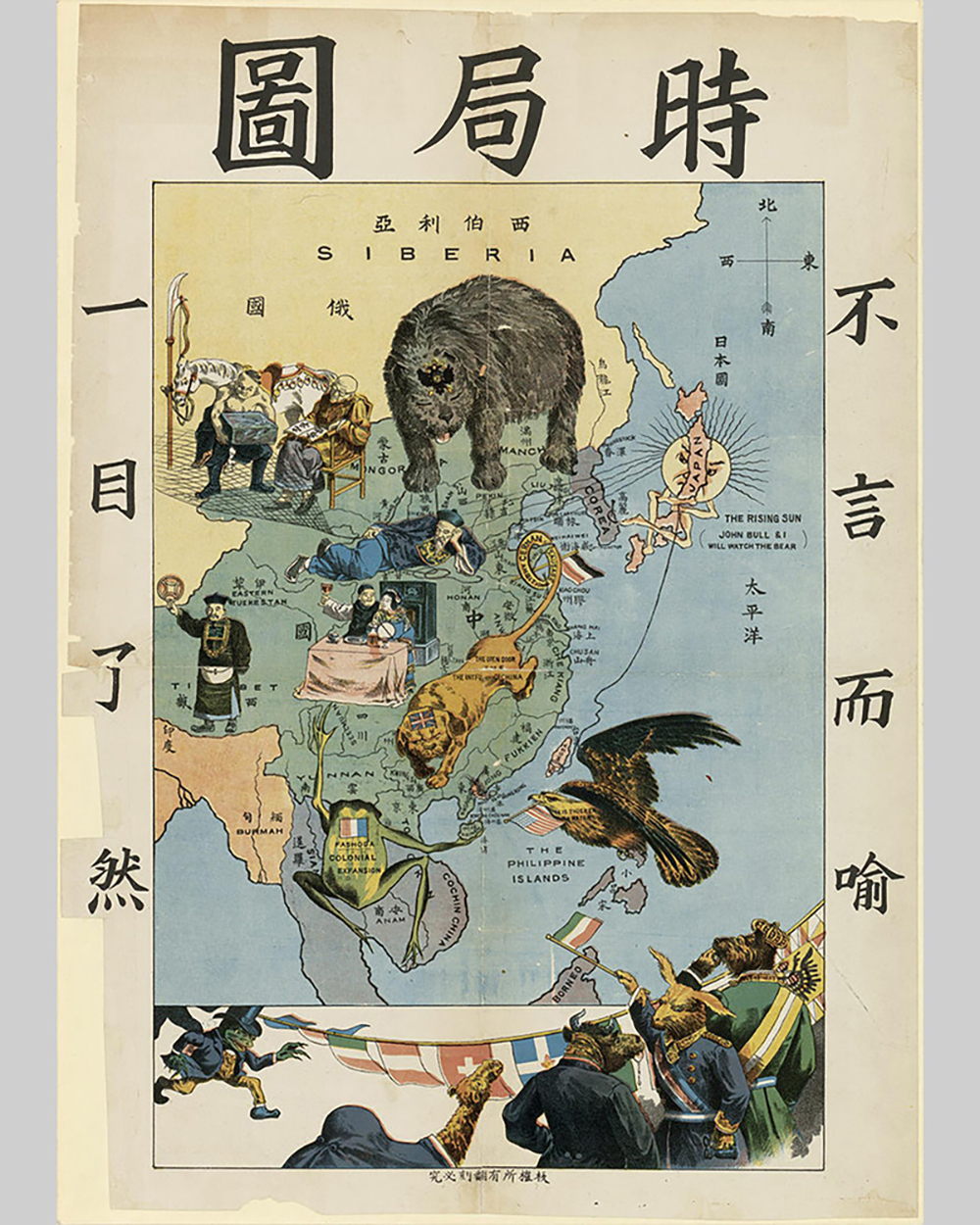
A current affairs illustration printed by Ching-chung Jih-pao, showing the partitioning of China by Russia and other imperialist powers




